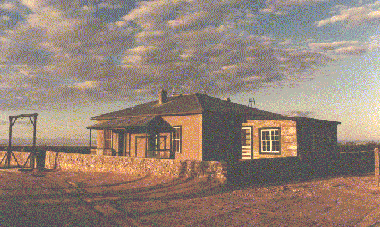Travel Pages
RomWell Travel Advisory
The Schmidt-McDonald Ranch House
The Schmidt-McDonald ranch house is located two miles south of Ground Zero. The property encompasses about three acres and consists of the main house and assorted outbuildings. The house, surrounded by a low stone wall, was built in 1913 by Franz Schmidt, a German immigrant and homesteader. In the 1920s Schmidt sold the ranch to George McDonald and moved to Florida.
The ranch house is a one-story, 1,750 square-foot adobe (mud bricks) building. An ice house is located on the west side along with an 9'- 4" deep underground cistern. A 14 by 18.5 foot stone addition, which included a modern bathroom, was added onto the north side in the 1930s. East of the house there is a large, divided concrete water storage tank and a windmill. South of the windmill are the remains of a bunkhouse, and a barn which also served as a garage. Further to the east are corrals and holding pens for livestock.
The McDonalds vacated their ranch house and their thousands of acres of marginal range land in early 1942 when it became part of the Alamogordo Bombing and Gunnery Range. The old house remained empty until Manhattan Project personnel arrived in 1945. Then a spacious room in the northeast corner of the house was selected by the Project personnel for the assembly of the plutonium core of the Trinity device. Workmen installed work benches, tables, and other equipment in this large room. To keep the desert dust and sand out, the room's windows and cracks were covered with plastic and sealed with tape. The core of the bomb consisted of two hemispheres of plutonium, (Pu- 239), and an initiator. According to reports, while scientists assembled the initiator and the Pu-239 hemispheres, jeeps were positioned outside with their engines running for a quick getaway if needed. Detection devices were used to monitor radiation levels in the room, and when fully assembled the core was warm to the touch. The completed core was later transported the two miles to Ground Zero, inserted into the bomb assembly, and raised to the top of the tower.
The Trinity explosion on Monday morning, July 16, did not significantly damage the McDonald house. Even though most of the windows were blown out, and the chimney was blown over, the main structure survived intact. Years of rain water dripping through holes in the metal roof did much more damage to the mud brick walls than the bomb did. The nearby barn did not fare as well. The Trinity test blew part of its roof off, and the roof has since totally collapsed.
The ranch house stood empty and deteriorating for 37 years until 1982 when the US Army stabilized it to prevent any further damage. The next year, the Department of Energy and the Army provided funds for the National Park Service to completely restore the house to the way it appeared in July, 1945. When the work was completed, the house with many photo displays on Trinity was opened to the public for the first time in October 1984 during the semi-annual tour. The Schmidt-McDonald ranch house is part of the Trinity National Historic Landmark.
RELATED LINKS:
 Learn About Trinity - The First Atomic Test
Learn About Trinity - The First Atomic Test
RECOMMENDED LITERATURE:
100 Suns - By Michael Light - Between July 1945 and November 1962 the United States is known to have conducted 216 atmospheric and underwater nuclear tests. After the Limited Test Ban Treaty between the United States and the Soviet Union in 1963, nuclear testing went underground. It became literally invisible—but more frequent: the United States conducted a further 723 underground tests, the last in 1992. 100 Suns documents the era of visible nuclear testing, the atmospheric era, with 100 photographs drawn by Michael Light from the archives at Los Alamos National Laboratory and the U.S. National Archives in Maryland. It includes previously classified material from the clandestine Lookout Mountain Air Force Station based in Hollywood, whose film directors, cameramen and still photographers were sworn to secrecy.
The title, 100 Suns, refers to the response by J. Robert Oppenheimer to the world’s first nuclear explosion in New Mexico when he quoted a passage from the Bhagavad Gita, the classic Vedic text: “If the radiance of a thousand suns were to burst forth at once in the sky, that would be like the splendor of the Mighty One... I am become Death, the destroyer of worlds.” This was Oppenheimer’s attempt to describe the otherwise indescribable. 100 Suns likewise confronts the indescribable by presenting without embellishment the stark evidence of the tests at the moment of detonation. Since the tests were conducted either in Nevada or the Pacific the book is simply divided between the desert and the ocean. Each photograph is presented with the name of the test, its explosive yield in kilotons or megatons, the date and the location. The enormity of the events recorded is contrasted with the understated neutrality of bare data.
Interspersed within the sequence of explosions are pictures of the awestruck witnesses. The evidence of these photographs is terrifying in its implication while at same time profoundly disconcerting as a spectacle. The visual grandeur of such imagery is balanced by the chilling facts provided at the end of the book in the detailed captions, a chronology of the development of nuclear weaponry and an extensive bibliography. A dramatic sequel to Michael Light’s Full Moon, 100 Suns forms an unprecedented historical document.
RECOMMENDED MOVIE:
The Day After Trinity - This unique movie is a haunting journey through the dawn of the nuclear age, an incisive history of humanity's most dubious achievement and the man behind it -- J. Robert Oppenheimer, the principal architect of the atomic bomb. Featuring archival footage and commentary from scientists and soldiers directly involved with the Manhattan Project, this gripping film is a fascinating look at the scope and power of the Nuclear Age.



